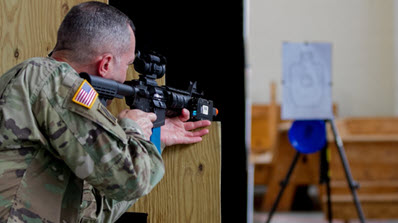The NNSS and U.S. Army are teaming to develop tactical readiness technology.
The long history of the Nevada National Security Site developing and deploying unique sensor technology has led to a partnership with the Department of Defense to advance U.S. Army combat personnel performance. This joint agency effort represents another facet of the NNSS expanding its national security mission.
The Measuring and Advancing Soldier Tactical Readiness and Effectiveness program, known as MASTR-E, will utilize wearable sensors – developed in partnership with the NNSS’ Special Technologies Laboratory (STL) – to measure, predict and enhance the dynamic decision making and readiness status of combat soldiers under stress. STL specializes in custom devices, measurement instruments and analysis methods for field deployment.
“I believe what NNSS is bringing to the table is the first of its kind,” said U.S. Army MASTR-E Program Manager George Matook. “Any high-stake, high-consequence environment that requires rapid decision making needs the ability to assess and understand how that affects the physiology of the person, whether shooting or making a financial transaction.”
The NNSS first engaged with the U.S. Army Combat Capabilities Development Command Soldier Center during a Special Operations Command event in late 2019 for human performance initiatives.
“We’ve grown into partnership at numerous levels and have developed an ongoing habitual relationship from organization to organization,” said George Papageorge, program manager for the NNSS’ Global Security Strategic Partnership Programs. “It’s really about how people in high-stress jobs regulate their physiology or understand their physiology so that can continue to operate under high-stress situations.”
Analyzing human performance data will not only enable soldiers to monitor their individual cognitive and motor factors, but will serve as the narrative for future training and operational posture. Cognitive, emotional, physical and social factors will be evaluated in order to find solutions to performance issues in high-stress environments.
“Army Futures Command is corralling all the forces to make one cohesive answer to human performance and what it means to helping our operators on the ground,” said NNSS Senior Principal Intelligence Analyst Ian O’Keefe. “It’s a multi-year effort. We’re working with a small group on prototype designs and introducing them to the training protocols. We collect data and metrics, then start to refine in order to determine formal training and development of formal products.”
Pilot testing for the program, slated through 2024, is scheduled to begin at Fort Devens, Massachusetts, in September.
“We’re really excited to have the partnership with the NNSS,” said U.S. Army Combat Capabilities Development Command Soldier Center Director Doug Tamilio. “One of the greatest parts of MASTR-E is the professional networks it brings for all invested in human performance. We’re getting closer to putting a tremendously useful capability in our Soldiers’ hands today, and making them more survivable and lethal. We are assessing the ability to make decisions under stress-in the moment and in the moments that matter.”

